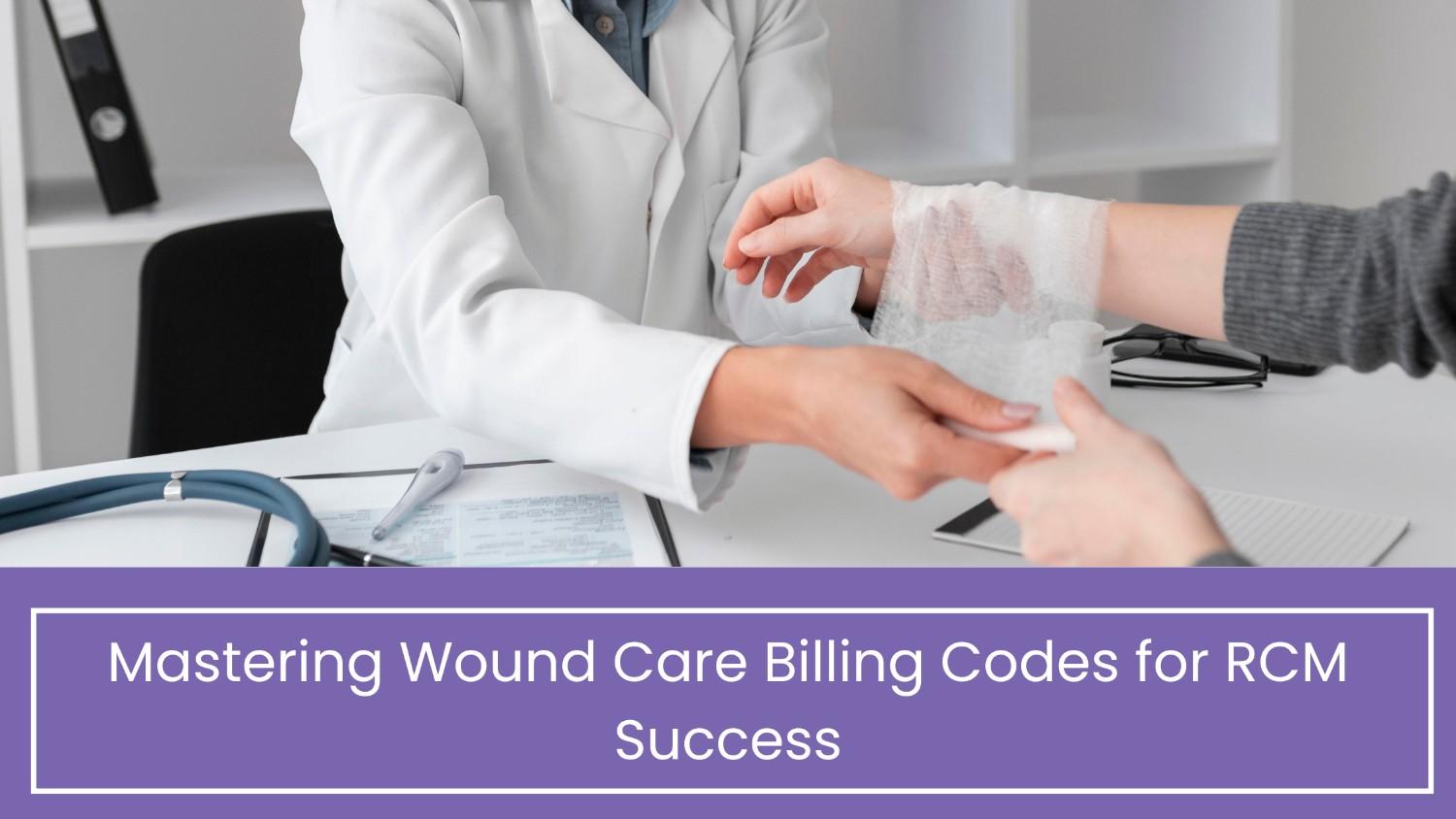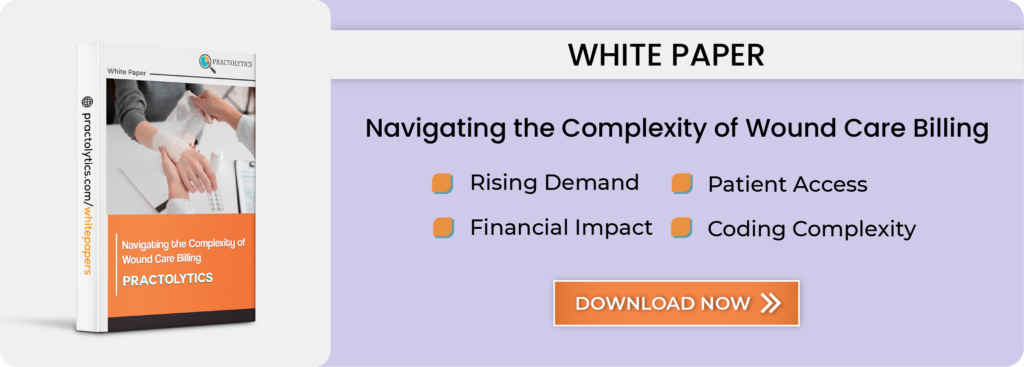Mastering Wound Care Billing Codes for RCM Success
Wound care is a critical area in healthcare that addresses various types of wounds, from acute and chronic wounds to surgical and trauma-related injuries. Efficient management of wound care not only improves patient outcomes but also ensures healthcare providers are appropriately reimbursed for their services. Navigating the complexities of wound care billing codes is essential for Revenue Cycle Management (RCM) success. This comprehensive guide will delve into the intricacies of wound care billing, providing insights and strategies for healthcare providers to optimize their billing processes.
Table of Contents
Understanding the Importance of Accurate Wound Care Coding
Accurate wound care coding is vital for several reasons
- Reimbursement: Proper coding ensures that healthcare providers receive appropriate compensation for the services rendered.
- Compliance: Adherence to coding standards helps avoid legal and financial penalties associated with improper billing.
- Quality Reporting: Accurate coding contributes to better health data, facilitating quality reporting and improvement initiatives.
- Operational Efficiency: Streamlined coding processes can enhance overall operational efficiency and reduce administrative burdens.
Key Wound Care Billing Codes and Their Applications
Wound care billing involves various codes, primarily falling under the ICD10, CPT, and HCPCS code sets. Understanding these codes is crucial for effective billing.
ICD10 Codes for Wound Care
The International Classification of Diseases, Tenth Revision (ICD10) codes are used to document diagnoses and reasons for encounters. Key ICD10 codes for wound care include:
- 0 L89.9: Pressure ulcers
- 0 S91.9: Open wounds of ankle and foot
- 31 T81.39: Complications of surgical wounds
- 1 L97.9: Non pressure chronic ulcers of lower limb
These codes must be used accurately to reflect the type, location, and severity of the wound.
CPT Codes for Wound Care Procedures
Current Procedural Terminology (CPT) codes describe the procedures and services performed by healthcare providers. Important CPT codes for wound care include:
- 97597: Debridement, open wound, including removal of devitalized tissue
- 97598: Each additional 20 square centimeters of wound debridement
- 11042: Debridement, subcutaneous tissue
- 11043: Debridement, muscle and/or fascia
- 11044: Debridement, bone
HCPCS Codes for Supplies and Equipment
Healthcare Common Procedure Coding System (HCPCS) codes are used for billing supplies, equipment, and certain services not covered by CPT codes. Key HCPCS codes for wound care include:
- A6203: Foam dressing, wound cover
- A6210: Nonsterile gauze for wound care
- A6402: Gauze, pad size
- E2402: Negative pressure wound therapy electrical pump
Strategies for Effective Wound Care Billing
To navigate wound care billing successfully, healthcare providers should implement the following strategies:
Comprehensive Documentation
Accurate and detailed documentation is the cornerstone of successful billing. Clinicians should document the following:
- Wound Description: Type, size, location, and severity
- Treatment Provided: Specific procedures and services performed
- Materials Used: Dressings, medications, and other supplies
- Patient Response: Healing progress and any complications
Regular Training and Education
Continuous education on coding updates and best practices is crucial. Providers and billing staff should:
- Stay Updated: Regularly review changes in ICD10, CPT, and HCPCS codes.
- Attend Workshops: Participate in coding workshops and webinars.
- Utilize Resources: Access coding manuals and online resources.
Utilize Technology
Leveraging technology can enhance coding accuracy and efficiency. Consider the following tools:
- Electronic Health Records (EHRs): Use EHR systems with integrated coding support.
- Coding Software: Employ coding software to assist in code selection and validation.
- Telemedicine Platforms: For remote wound care services, use platforms with built-in billing functionalities.
Audit and Review Processes
Regular audits and reviews are essential to identify and correct billing issues. Implement the following practices:
- Internal Audits: Conduct routine audits of wound care billing to ensure accuracy.
- External Reviews: Engage third party reviewers for an objective assessment.
- Feedback Mechanism: Establish a feedback loop to address identified issues promptly.
Patient Education and Engagement
Educating patients about their wound care treatment and billing can improve transparency and satisfaction. Consider these approaches:
- Billing Information: Provide clear explanations of billing processes and charges.
- Treatment Plans: Discuss treatment plans and expected outcomes with patients.
- Support Resources: Offer resources to assist patients with billing inquiries.
Common Challenges in Wound Care Billing and How to Overcome Them
Wound care billing presents unique challenges that can impact RCM success. Identifying and addressing these challenges is crucial.
Complex Coding Requirements
Wound care often involves multiple codes for different aspects of treatment. To manage this complexity:
- Use Code Bundling: Where applicable, bundle codes to simplify billing.
- Cross Reference Documentation: Ensure all aspects of care are documented and coded.
- Consult Coding Experts: Engage coding specialists for complex cases.
Insurance Rejections and Denials
- Preauthorization: Obtain preauthorization for services when required.
- Eligibility Verification: Verify patient insurance eligibility before treatment.
- Appeal Denials: Develop a robust process for appealing denials with proper documentation.
Variability in Reimbursement Rates
Reimbursement rates for wound care services can vary significantly. To navigate this variability:
- Contract Negotiation: Negotiate favorable rates with insurance providers.
- Cost Analysis: Conduct regular cost analyses to ensure services are financially viable.
- Diversified Payer Mix: Maintain a diversified payer mix to mitigate risks associated with rate variability.
Documentation Gaps
- Standardized Templates: Use standardized templates for wound care documentation.
- Training Programs: Train staff on proper documentation practices.
- Realtime Documentation: Encourage real time documentation to capture all details accurately.
Future Trends in Wound Care Billing
As healthcare continues to evolve, wound care billing is likely to be influenced by several emerging trends. The shift towards value-based care emphasizes outcomes over volume, focusing on quality metrics such as healing rates and patient satisfaction, participating in bundled payment programs for comprehensive wound care, and leveraging performance-based incentives to enhance revenue. Value-based care models align reimbursement with patient outcomes, promoting better care.
Telemedicine is becoming increasingly integral to wound care, with appropriate telehealth billing codes for remote consultations, billing for remote monitoring services when applicable, and staying informed about evolving telehealth reimbursement policies. Integrating telemedicine into wound care can expand service reach and improve patient access. Additionally, AI and automation technologies offer significant potential for wound care billing, with AI-driven coding solutions to enhance accuracy, predictive analytics for revenue forecasting and denial management, and workflow automation to improve efficiency. Harnessing AI and automation can streamline billing processes and reduce administrative burdens.
Navigating the complexities of wound care billing codes is essential for RCM success. By understanding key billing codes, implementing effective strategies, addressing common challenges, and staying abreast of future trends, healthcare providers can optimize their billing processes and ensure appropriate reimbursement for wound care services. Accurate documentation, continuous education, and leveraging technology are critical components of an efficient wound care billing system. With a proactive approach, providers can enhance operational efficiency, improve patient outcomes, and achieve financial stability in the dynamic landscape of wound care.
At Practolytics, we specialize in streamlining wound care billing processes for healthcare providers. Our expertise in revenue cycle management, combined with cutting-edge technology and a dedicated team, ensures that your practice receives accurate and timely reimbursements. By partnering with Practolytics, you can focus on delivering exceptional patient care while we handle the intricacies of your billing operations. Our proactive approach and commitment to excellence drive operational efficiency and financial stability, empowering your practice to thrive in the ever-evolving healthcare industry.
RECOMMENDED TO READ – Common Wound Care Billing Pitfalls and How to Avoid Them: Tips for RCM Success
Talk to Medical Billing Expert Today — Get a Free Demo Now!






